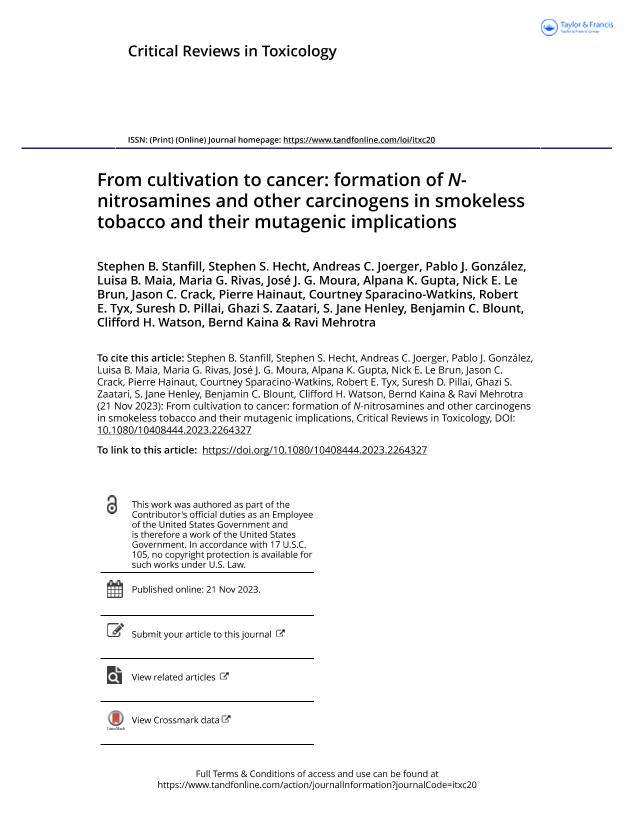Artículo
From cultivation to cancer: Formation of N-nitrosamines and other carcinogens in smokeless tobacco and their mutagenic implications
Stanfill, Stephen B.; Hecht, Stephen S.; Joerger, Andreas C.; González, Pablo Javier ; Maia, Luisa B.; Rivas, Maria Gabriela
; Maia, Luisa B.; Rivas, Maria Gabriela ; Moura, José J. G.; Gupta, Alpana K.; Le Brun, Nick E.; Crack, Jason C.; Hainaut, Pierre; Sparacino Watkins, Courtney; Tyx, Robert E.; Pillai, Suresh D.; Zaatari, Ghazi S.; Henley, S. Jane; Blount, Benjamin C.; Watson, Clifford H.; Kaina, Bernd; Mehrotra, Ravi
; Moura, José J. G.; Gupta, Alpana K.; Le Brun, Nick E.; Crack, Jason C.; Hainaut, Pierre; Sparacino Watkins, Courtney; Tyx, Robert E.; Pillai, Suresh D.; Zaatari, Ghazi S.; Henley, S. Jane; Blount, Benjamin C.; Watson, Clifford H.; Kaina, Bernd; Mehrotra, Ravi
 ; Maia, Luisa B.; Rivas, Maria Gabriela
; Maia, Luisa B.; Rivas, Maria Gabriela ; Moura, José J. G.; Gupta, Alpana K.; Le Brun, Nick E.; Crack, Jason C.; Hainaut, Pierre; Sparacino Watkins, Courtney; Tyx, Robert E.; Pillai, Suresh D.; Zaatari, Ghazi S.; Henley, S. Jane; Blount, Benjamin C.; Watson, Clifford H.; Kaina, Bernd; Mehrotra, Ravi
; Moura, José J. G.; Gupta, Alpana K.; Le Brun, Nick E.; Crack, Jason C.; Hainaut, Pierre; Sparacino Watkins, Courtney; Tyx, Robert E.; Pillai, Suresh D.; Zaatari, Ghazi S.; Henley, S. Jane; Blount, Benjamin C.; Watson, Clifford H.; Kaina, Bernd; Mehrotra, Ravi
Fecha de publicación:
11/2023
Editorial:
Taylor & Francis
Revista:
Critical Reviews In Toxicology
ISSN:
1040-8444
Idioma:
Inglés
Tipo de recurso:
Artículo publicado
Clasificación temática:
Resumen
Tobacco use is a major cause of preventable morbidity and mortality globally. Tobacco products, including smokeless tobacco (ST), generally contain tobacco-specific N-nitrosamines (TSNAs), such as N′-nitrosonornicotine (NNN) and 4-(methylnitrosamino)-1-(3-pyridyl)-butanone (NNK), which are potent carcinogens that cause mutations in critical genes in human DNA. This review covers the series of biochemical and chemical transformations, related to TSNAs, leading from tobacco cultivation to cancer initiation. A key aim of this review is to provide a greater understanding of TSNAs: their precursors, the microbial and chemical mechanisms that contribute to their formation in ST, their mutagenicity leading to cancer due to ST use, and potential means of lowering TSNA levels in tobacco products. TSNAs are not present in harvested tobacco but can form due to nitrosating agents reacting with tobacco alkaloids present in tobacco during certain types of curing. TSNAs can also form during or following ST production when certain microorganisms perform nitrate metabolism, with dissimilatory nitrate reductases converting nitrate to nitrite that is then released into tobacco and reacts chemically with tobacco alkaloids. When ST usage occurs, TSNAs are absorbed and metabolized to reactive compounds that form DNA adducts leading to mutations in critical target genes, including the RAS oncogenes and the p53 tumor suppressor gene. DNA repair mechanisms remove most adducts induced by carcinogens, thus preventing many but not all mutations. Lastly, because TSNAs and other agents cause cancer, previously documented strategies for lowering their levels in ST products are discussed, including using tobacco with lower nornicotine levels, pasteurization and other means of eliminating microorganisms, omitting fermentation and fire-curing, refrigerating ST products, and including nitrite scavenging chemicals as ST ingredients.
Archivos asociados
Licencia
Identificadores
Colecciones
Articulos(CCT - SANTA FE)
Articulos de CTRO.CIENTIFICO TECNOL.CONICET - SANTA FE
Articulos de CTRO.CIENTIFICO TECNOL.CONICET - SANTA FE
Citación
Stanfill, Stephen B.; Hecht, Stephen S.; Joerger, Andreas C.; González, Pablo Javier; Maia, Luisa B.; et al.; From cultivation to cancer: Formation of N-nitrosamines and other carcinogens in smokeless tobacco and their mutagenic implications; Taylor & Francis; Critical Reviews In Toxicology; 53; 10; 11-2023; 658-701
Compartir
Altmétricas



